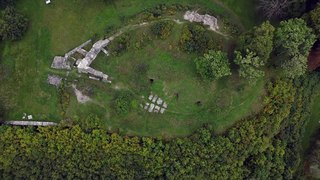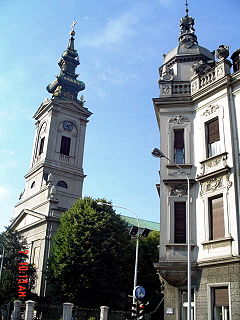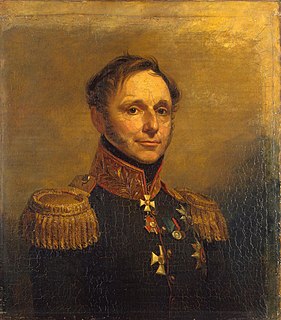Contents
- Harju County
- Tallinn
- Ida-Viru County
- Järva County
- Paide
- Lääne County
- Haapsalu
- Lihula
- Nõva
- Vormsi
- Pärnu County
- Pärnu
- Saare County
- Kuressaare
- Tartu County
- Tartu
This is a list of cemeteries in Estonia.
This is a list of cemeteries in Estonia.

Alexander Yaroslavich Nevsky served as Prince of Novgorod, Grand Prince of Kiev (1236–52) and Grand Prince of Vladimir (1252–63) during some of the most difficult times in Kievan Rus' history.

Harju County, is one of the fifteen counties of Estonia. It is situated in Northern Estonia, on the southern coast of the Gulf of Finland, and borders Lääne-Viru County to the east, Järva County to the southeast, Rapla County to the south, and Lääne County to the southwest. The capital and largest city of Estonia, Tallinn, is situated in Harju County. Harju County is the largest county in Estonia in terms of population, as almost half (45%) of the Estonia's population lives in Harju County.

Nevsky Prospect is the main street in the federal city of St. Petersburg in Russia. It takes its name from the Alexander Nevsky Lavra, the monastery which stands at the eastern end of the street, and which in turn commemorates the Russian hero Prince Saint Alexander Nevsky (1221–1263). Following his founding of Saint Petersburg in 1703, Tsar Peter I planned the course of the street as the beginning of the road to Novgorod and Moscow. The avenue runs from the Admiralty in the west to the Moscow Railway Station and, after veering slightly southwards at Vosstaniya Square, to the Alexander Nevsky Lavra.

The Byzantine Revival was an architectural revival movement, most frequently seen in religious, institutional and public buildings. It incorporates elements of the Byzantine style associated with Eastern and Orthodox Christian architecture dating from the 5th through 11th centuries, notably that of Constantinople and the Exarchate of Ravenna. Neo-Byzantine architecture emerged in the 1840s in Western Europe and peaked in the last quarter of the 19th century in the Russian Empire, and later Bulgaria. The Neo-Byzantine school was active in Yugoslavia between World War I and World War II.

Saint Alexander Nevsky Lavra or Saint Alexander Nevsky Monastery was founded by Peter I of Russia in 1710 at the eastern end of the Nevsky Prospekt in Saint Petersburg supposing that that was the site of the Neva Battle in 1240 when Alexander Nevsky, a prince, defeated the Swedes; however, the battle actually took place about 12 miles (19 km) away from that site. "On April 5, 1713, in St. Petersburg, in the presence of Peter I, the wooden Church of the Annunciation was consecrated. This day is considered the official founding date of the Alexander Nevsky Lavra."

Gustav Fabergé was a Baltic German jeweller and father of Peter Carl Fabergé, maker of Fabergé eggs. He established his own business in Saint Petersburg, which his son inherited.
The St. Thomas Church is a Lutheran church in Leipzig, Germany. It is associated with several well-known composers such as Richard Wagner and Felix Mendelssohn Bartholdy, and especially Johann Sebastian Bach, who worked here as a Kapellmeister from 1723 until his death in 1750. Today, the church also holds his remains. Martin Luther preached here in 1539.

Lihula is a town in Lääneranna Parish, Pärnu County, Estonia.

The Alexander Nevsky Cathedral was the main Russian Orthodox cathedral in Baku, Azerbaijan from when it was completed in 1898 until its destruction in 1937 during the Soviet era under Joseph Stalin. The cathedral was the biggest Russian Orthodox structure ever built in the South Caucasus.

Belgrade, Serbia has an abundance of religious architecture. The city has numerous Serbian Orthodox churches and temples and it is also the seat of the Patriarch of the Serbian Orthodox Church. Its two most prominent Orthodox Christian places of worship are the Saborna Crkva and the Temple of St. Sava, the largest Eastern Orthodox church in the world.

Monument of Lihula is the colloquial name of a monument commemorating the Estonians who fought for Estonia against the Soviet Union in World War II, located in a privately owned museum in Lagedi, Estonia. The monument has been controversial due to, in part, its dedication to those who served in the German Wehrmacht and particularly in the Waffen-SS.

The Kopli cemetery was Estonia's largest Lutheran Baltic German cemetery, located in the suburb of Kopli in Tallinn. It contained thousands of graves of prominent citizens of Tallinn and stood from 1774 to shortly after World War II, when it was completely flattened and destroyed by the Soviet occupation authorities governing the country at the time. The former cemetery is now a public park.
The appearance of St. Petersburg includes long, straight boulevards, vast spaces, gardens and parks, decorative wrought-iron fences, monuments and decorative sculptures. The Neva River itself, together with its many canals and their granite embankments and bridges help to give the city its particular ambience.

Count Peter Essen was a Baltic German General of the Infantry in 1819 and a count (1833). He belongs to the bourgeois Essen family from Pärnu. Essen's only daughter, Alexandrine Essen (1816–1868), married count Pontus von Stenbock-Fermor (1806–1866) in 1835, at which point they began using the joint name Essen-Stenbock-Fermor.
The following is a timeline of the history of the city of Tallinn, Estonia.
The following is a timeline of the history of the city of Vilnius, Lithuania.

Lazarevskoe Cemetery is a historic cemetery in the centre of Saint Petersburg, and the oldest surviving cemetery in the city. It is part of the Alexander Nevsky Lavra, and is one of four cemeteries in the complex. Since 1932 it has been part of the State Museum of Urban Sculpture, which refers to it as the Necropolis of the XVIII century. It covers 0.7 hectares.
Siselinna Cemetery is a cemetery area in Juhkentali subdistrict, Tallinn, Estonia. Its area is 18.3 ha.

Indura is a village in the Grodno District of the Grodno Region of Belarus.